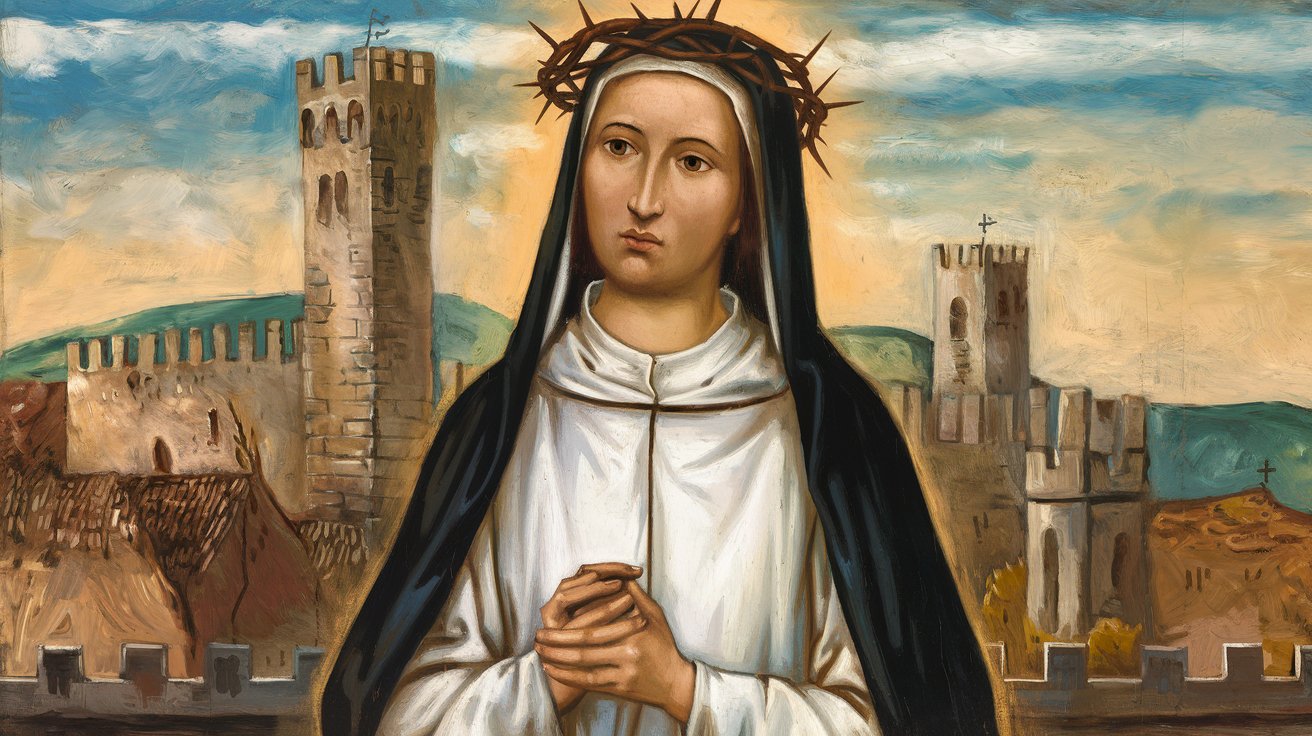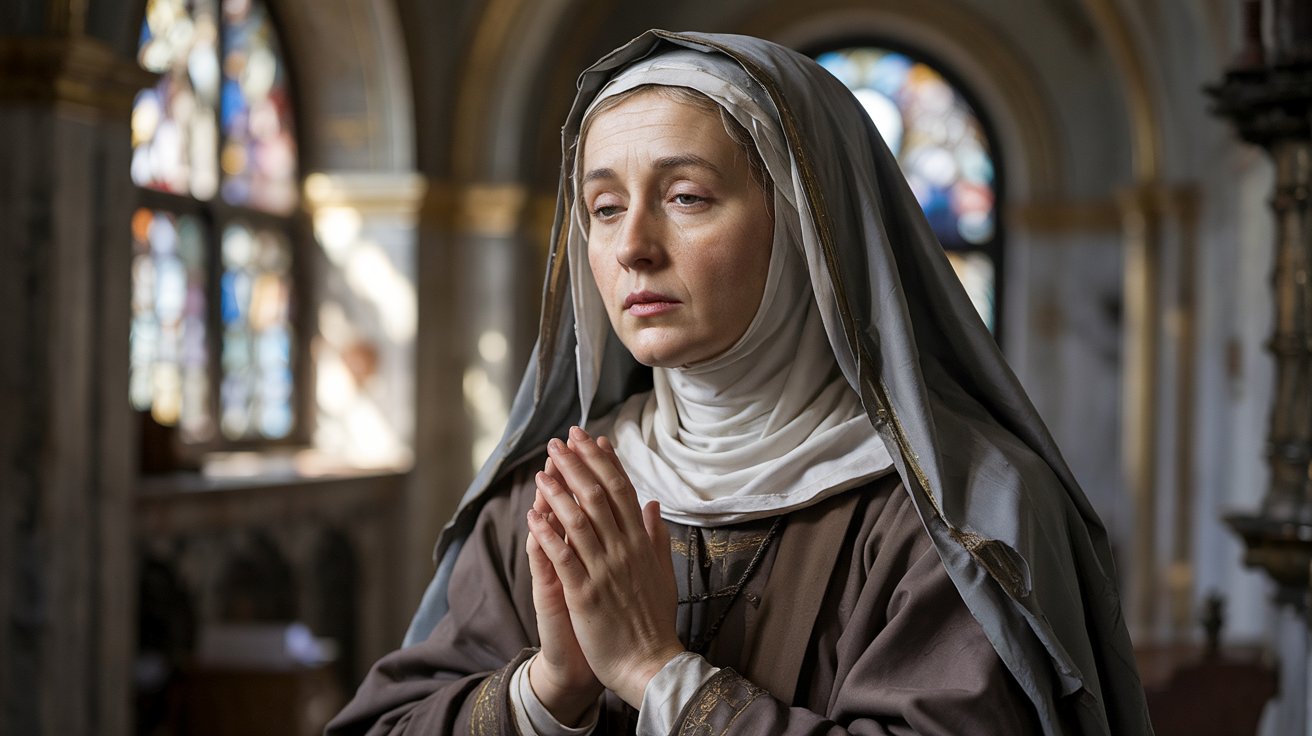Early Life and Background
Caterina di Giacomo di Benincasa, known today as Catherine of Siena, was born on March 25, 1347 in Siena, Italy. She was the 24th child of a well-to-do wool-dyer, Jacopo Benincasa, and his wife Lapa Piagenti. Remarkably, Catherine’s birth came just before the Black Death ravaged Europe, and she grew up amid the turbulence of 14th-century Italy, a time of war, plague, and religious upheaval. From a young age, Catherine showed deep devotion.
According to her first biographer and spiritual director Raymond of Capua, little Catherine had an extraordinary vision of Christ in glory accompanied by Saints Peter, Paul, and John. At age seven, she privately vowed her life to God, an astonishing commitment for a child. Despite her piety, her parents hoped she would marry. When her older sister died in childbirth, the family pressured Catherine to wed the widower. The teenage Catherine boldly refused; she cut off her long hair to deter suitors and undertook strict fasts as a protest against marriage. Eventually, her family relented, impressed by her iron will and holiness.
At 16, Catherine joined the “mantellate,” a lay sisterhood of Dominican tertiaries in Siena. As a tertiary, she lived at home but wore a simple habit and spent hours in prayer and service. The mantellate taught her to read, and she immersed herself in Scripture and the lives of saints. Catherine embraced an austere lifestyle – nearly constant prayer, severe fasting, and caring for the poor and sick of Siena. She even served plague victims and, in one legendary act of charity, drank the diseased sores of a cancer patient to overcome her natural revulsion and prove her love of Christ in the sufferer.
Her intense asceticism left her frequently ill, but also deepened her spiritual experiences. In 1366, around age 19, she experienced what she described as a “Mystical Marriage” to Jesus—a vision in which Christ placed a ring (visible only to her) on her finger, symbolizing her total union with Him. She said the ring was “not of gold, but of Christ’s own flesh.” After this vision, Catherine felt God calling her out of her secluded life of prayer to enter the public life of the world and serve others.
Journey to Sainthood and Significant Contributions
Obeying this divine summons, Catherine emerged from solitude and began ministering actively. In the late 1360s, she devoted herself to helping the poor, nursing the sick, and comforting prisoners in Siena. Her reputation for holiness spread, attracting a band of followers—women and men, clergy and lay—who looked to her for spiritual guidance.
Though she had no formal education, Catherine became a counselor and teacher, advising all who sought her wisdom. She corresponded by letter with people from every walk of life, from local peasants to the highest officials of church and state. These letters display an astounding clarity of thought, charity, and boldness for a young laywoman. Around 1370, Catherine began to dictate what would become her greatest spiritual work, The Dialogue of Divine Providence, an account of her mystical conversations with God.
Catherine’s most significant contributions unfolded on the political stage of the Church. At that time, the papacy had relocated to Avignon, France, and much of Italy was in turmoil. Catherine felt divinely charged to heal the Church’s wounds. She wrote urgent letters to Pope Gregory XI, imploring him to return the papacy to Rome and reform the corrupt clergy. In 1376, Catherine undertook a dangerous journey to Avignon as an ambassador of peace.
Dressed in her plain Dominican habit, the 29-year-old mystic met Pope Gregory XI in person. With tears and passionate pleas, she persuaded the hesitant pontiff to come back to Rome. Astonishingly, Gregory XI heeded her counsel: in January 1377, he left Avignon and restored the Holy See to Rome—a move Catherine had ardently worked for. This achievement, nearly unheard of for a woman and layperson of her time, cemented her status as a powerful spiritual influence. She even called the pope “Sweet Christ on Earth,” emphasizing her profound respect for the papal office even as she delivered blunt critiques.
Catherine also mediated conflicts between warring Italian city-states. In Florence, her hometown’s traditional rival, she attempted to broker peace between the Florentines and the papal states. Although initially rejected—at one point she was nearly assassinated by a mob during civil unrest—her efforts eventually helped end hostilities.
During the Great Schism of 1378, when rival popes were elected (one in Rome, one in Avignon), Catherine staunchly supported the legitimate Roman Pope Urban VI. She moved to Rome at Urban’s request, writing letters to princes, cardinals, and even the rival Avignon pope, urging loyalty to Urban to heal the schism. Her fearless advocacy for Church unity during this crisis further marked her as an extraordinary servant of God and the Church.
Miracles and Key Events
Throughout her life, Catherine was known for remarkable phenomena that signaled her sanctity. She had frequent ecstasies and visions during prayer. Witnesses attested that at times her face would shine and she would be insensible to the world around her, absorbed in divine conversation. During one such ecstatic prayer in 1375, while in Pisa, Catherine received the stigmata—the wounds of Christ—on her own body.
Uniquely, she prayed that the marks be invisible, so they remained hidden until after her death. Catherine also experienced a mystical exchange of hearts with Christ: she prayed, “Lord, take away my heart and give me Yours,” and in a vision Jesus appeared, opened her side, and placed His own heart within her. After this, she said she lived with Christ’s heart beating in her—a symbol of her complete union with the love of God.
Numerous miracles of healing are attributed to Catherine. She nursed plague victims without contracting the illness, cured some by her touch or prayer, and was said to have raised at least one person from the dead. Despite severe fasting (often taking no food except the Eucharist for long periods), she maintained the energy to travel and preach. In her final years, her personal miraculous endurance itself astonished onlookers: from the beginning of 1380, she could neither eat nor even swallow water, yet she remained spiritually vigorous.
So extreme was her abstinence that clergy grew concerned, but Catherine explained she had “food to eat of which you do not know,” believing Christ sustained her. During Mass, witnesses saw her levitating, and one priest testified that the consecrated Host flew from his hands to her tongue—a sign of divine favor.
Another key event was her “mystical marriage” in 1368, which she regarded as a turning point empowering her public mission. And of course, her persuasion of Pope Gregory XI in 1376 was arguably miraculous on a political level—an unheard-of accomplishment for a young woman, credited to her inspired eloquence and holiness. By the time of her death, Catherine’s fame as a worker of wonders and a prophetess of reform had spread across Europe.
Interactions with Other Saints and Biblical Figures
As a Third Order Dominican, Catherine was surrounded by the spiritual heritage of St. Dominic and his friars. She corresponded with and was guided by several Dominican priests, including Blessed Raymond of Capua, who became her confessor and later Master General of the Dominicans.
It was Raymond who encouraged her to dictate her revelations and later wrote her biography, spreading her story after her death. Catherine also interacted with figures such as Saint Agnes of Montepulciano; although they did not meet, she venerated Agnes and visited her tomb, drawing inspiration from that earlier mystic.
In mystical terms, Catherine reported frequent visions of Jesus, Mary, and various saints. She had a special devotion to St. Mary Magdalene and St. Dominic, often seeing them in visions. Her mystical marriage was essentially an interaction with Christ Himself, whom she called her Bridegroom.
She also experienced visits from the Virgin Mary, who comforted and guided her. These heavenly figures were as real to her as her earthly friends, and she spoke of “Christ crucified” as her love and “Mama Mary” as her mother.
Remarkably, Catherine’s most historically significant interactions were with living figures of her time who later attained sainthood or high repute. Besides Raymond, she was close to Blessed Niccolò di Toldo, a condemned prisoner whom she prepared for a holy death, and she corresponded with St. Bernardine of Siena, who later promoted her cult.
Notably, her influence reached even into later generations, with St. Joan of Arc venerating Catherine and carrying her image on a banner in battle.
Timeline of Saint Catherine’s Life
- 1347 – Catherine is born in Siena, Italy, into the Benincasa family during the Black Death.
- 1353 – As a young child, she experiences a vision of Christ with apostles Peter, Paul, and John.
- 1355 – At age 7, she vows perpetual virginity and dedicates herself to God.
- 1362 – Around age 15, facing pressure to marry, she cuts off her hair in protest and is allowed to live as an unmarried, devout woman.
- 1363 – Catherine joins the Dominican Third Order (Mantellate) and begins serving the poor and sick while deepening her prayer life.
- 1366–1368 – Undergoes a profound spiritual crisis and then experiences her “Mystical Marriage” to Christ, marking a transition to public ministry.
- 1370 – Receives a visionary commission from God to heal the Church and care for souls, and begins dictating her major treatise, The Dialogue of Divine Providence.
- 1375 – In Pisa, she receives the invisible stigmata while in ecstatic prayer, sealing her union with Christ’s passion.
- 1376 – Travels to Avignon to meet Pope Gregory XI, pleading with him to return the papacy to Rome and meditating on Church reform.
- 1377 – Returns to Italy, founds a women’s monastery in Siena, and writes letters urging reform and peace.
- 1378 – The Great Schism begins; she supports Pope Urban VI and writes to heal the divide.
- 1380 – Gravely ill and unable to walk, she offers her life for Church unity and dies in Rome at age 33.
- 1461 – Catherine is canonized by Pope Pius II.
- 1970 – Proclaimed a Doctor of the Church by Pope Paul VI.
- 1999 – Named one of the Patron Saints of Europe by Pope John Paul II.
Legacy and Influence
St. Catherine of Siena’s legacy is extraordinary despite her short life. She emerged as a counselor of popes and kings, a healer of schism, and a reformer at a time when the Church was deeply divided. Her courageous intervention in the papacy’s move from Avignon to Rome and her steadfast support during the Western Schism marked her as one of the most influential women in Church history.
Her writings—The Dialogue of Divine Providence, her letters, and prayers—form a treasury of mystical theology and practical wisdom. Declared a Doctor of the Church, her teachings on divine love, humility, and prayer continue to be cherished. Her personal holiness, severe asceticism, and mystical experiences set her apart as an exemplary mystic whose life demonstrates that sanctity transcends social boundaries. Today, Catherine is revered as a peacemaker, and her legacy continues to ignite change and inspire devotion in the Church and beyond.







